Melt-Spinning Mesophase Pitch-Based Graphite Fibers as Anode Materials for High-Rate Lithium-Ion Batteries
Abstract
:1. Introduction
2. Materials and Methods
2.1. Material Synthesis
2.2. Material Characterizations
2.3. Battery Preparation
2.4. Electrochemical Tests
3. Results and Discussion
3.1. Morphological and Chemical Characterization
3.2. Electrochemical Characterization
4. Conclusions
Author Contributions
Funding
Informed Consent Statement
Data Availability Statement
Conflicts of Interest
References
- Brockway, P.E.; Owen, A.; Brand-Correa, L.I.; Hardt, L. Estimation of global final-stage energy-return-on-investment for fossil fuels with comparison to renewable energy sources. Nat. Energy 2019, 4, 612–621. [Google Scholar] [CrossRef]
- Fan, E.; Li, L.; Wang, Z.; Lin, J.; Huang, Y.; Yao, Y.; Chen, R.; Wu, F. Sustainable recycling technology for Li-ion batteries and beyond: Challenges and future prospects. Chem. Rev. 2020, 120, 7020–7063. [Google Scholar] [CrossRef] [PubMed]
- Behabtu, H.A.; Messagie, M.; Coosemans, T.; Berecibar, M.; Anlay Fante, K.; Kebede, A.A.; Mierlo, J.V. A review of energy storage technologies’ application potentials in renewable energy sources grid integration. Sustainability 2020, 12, 10511. [Google Scholar] [CrossRef]
- Yin, H.; Han, D.; Yu, X.; Cao, M.; Hou, Z.; Li, C.; Zhu, M.-Q. Recent advances in electrospun metal chalcogenide anodes for lithium-ion and sodium-ion batteries. ACS Appl. Energy Mater. 2023, 6, 1155–1175. [Google Scholar] [CrossRef]
- Kim, T.; Song, W.; Son, D.-Y.; Ono, L.K.; Qi, Y. Lithium-ion batteries: Outlook on present, future, and hybridized technologies. J. Mater. Chem. 2019, 7, 2942–2964. [Google Scholar] [CrossRef]
- Dunn, B.; Kamath, H.; Tarascon, J.M. Electrical energy storage for the grid: A battery of choices. Science 2011, 334, 928–935. [Google Scholar] [CrossRef]
- Sun, Y.; Liu, N.; Cui, Y. Promises and challenges of nanomaterials for lithium-based rechargeable batteries. Nat. Energy 2016, 1, 16071. [Google Scholar] [CrossRef]
- Park, S.-H.; King, P.J.; Tian, R.; Boland, C.S.; Coelho, J.; Zhang, C.; McBean, P.; McEvoy, N.; Kremer, M.P.; Daly, D.; et al. High areal capacity battery electrodes enabled by segregated nanotube networks. Nat. Energy 2019, 4, 560–567. [Google Scholar] [CrossRef]
- Balogun, M.-S.; Yang, H.; Luo, Y.; Qiu, W.; Huang, Y.; Liu, Z.-Q.; Tong, Y. Achieving high gravimetric energy density for flexible lithium-ion batteries facilitated by core-double-shell electrodes. Energy Environ. Sci. 2018, 11, 1859–1869. [Google Scholar] [CrossRef]
- Duan, J.; Tang, X.; Dai, H.; Yang, Y.; Wu, W.; Wei, X.; Huang, Y. Building safe lithium-ion batteries for electric vehicles: A review. Electrochem. Energy Rev. 2022, 3, 1–42. [Google Scholar] [CrossRef]
- Palomares, V.; Nieto, N.; Rojo, T. Negative electrode materials for high-energy density Li-and Na-ion batteries. Curr. Opin. Electrochem. 2022, 31, 100840. [Google Scholar] [CrossRef]
- Cheng, H.; Shapter, J.G.; Li, Y.; Gao, G. Recent progress of advanced anode materials of lithium-ion batteries. J. Energy Chem. 2021, 57, 451–468. [Google Scholar] [CrossRef]
- Balogun, M.-S.; Qiu, W.; Luo, Y.; Meng, H.; Mai, W.; Onasanya, A.; Olaniyi, T.K.; Tong, Y. A review of the development of full cell lithium-ion batteries: The impact of nanostructured anode materials. Nano Res. 2016, 9, 2823–2851. [Google Scholar] [CrossRef]
- Li, S.; Wang, K.; Zhang, G.; Li, S.; Xu, Y.; Zhang, X.; Zhang, X.; Zheng, S.; Sun, X.; Ma, Y. Fast charging anode materials for lithium-ion batteries: Current status and perspectives. Adv. Funct. Mater. 2022, 32, 2200796. [Google Scholar] [CrossRef]
- Mo, R.; Li, F.; Tan, X.; Xu, P.; Tao, R.; Shen, G.; Lu, X.; Liu, F.; Shen, L.; Xu, B.; et al. High-quality mesoporous graphene particles as high-energy and fast-charging anodes for lithium-ion batteries. Nat. Commun. 2019, 10, 1474. [Google Scholar] [CrossRef] [PubMed]
- Lee, B.S. A review of recent advancements in electrospun anode materials to improve rechargeable lithium battery performance. Polymers 2020, 12, 2035. [Google Scholar] [CrossRef]
- An, S.J.; Li, J.; Daniel, C.; Mohanty, D.; Nagpure, S.; Wood, D.L. The state of understanding of the lithium-ion-battery graphite solid electrolyte interphase (SEI) and its relationship to formation cycling. Carbon 2016, 105, 52–76. [Google Scholar] [CrossRef]
- Shen, C.; Hu, G.; Cheong, L.; Huang, S.; Zhang, J.; Wang, D. Direct observation of the growth of lithium dendrites on graphite anodes by operando EC-AFM. Small Methods 2018, 2, 1700298. [Google Scholar] [CrossRef]
- Zaghib, K.; Brochu, F.; Guerfi, A.; Kinoshita, K. Effect of particle size on lithium intercalation rates in natural graphite. J. Power Sources 2001, 103, 140–146. [Google Scholar] [CrossRef]
- Verma, P.; Sasaki, T.; Novák, P. Chemical surface treatments for decreasing irreversible charge loss and preventing exfoliation of graphite in Li-ion batteries. Electrochim. Acta 2012, 82, 233–242. [Google Scholar] [CrossRef]
- Shim, J.; Striebel, K.A. Electrochemical characterization of thermally oxidized natural graphite anodes in lithium-ion batteries. J. Power Sources 2007, 164, 862–867. [Google Scholar] [CrossRef]
- Lin, Y.; Huang, Z.-H.; Yu, X.; Shen, W.; Zheng, Y.; Kang, F. Mildly expanded graphite for anode materials of lithium ion battery synthesized with perchloric acid. Electrochim. Acta 2014, 116, 170–174. [Google Scholar] [CrossRef]
- Liu, X.; Liu, E.; Chao, D.; Chen, L.; Liu, S.; Wang, J.; Li, Y.; Zhao, J.; Kang, Y.-M.; Shen, Z. Large size nitrogen-doped graphene-coated graphite for high performance lithium-ion battery anode. RSC Adv. 2016, 6, 104010–104015. [Google Scholar] [CrossRef]
- Kang, S.-X.; Lun, H.; Qi, Y.-X.; Bai, X.; Li, X.-R.; Yang, H.; An, J.; Kong, L.-Y.; Bai, Y.-J. Boosted electrochemical performance of graphite anode enabled by polytetrafluoroethylene-derived F-doping. Mater. Chem. Phys. 2021, 261, 124214. [Google Scholar] [CrossRef]
- Yoo, E.; Kim, J.; Hosono, E.; Zhou, H.-S.; Kudo, T.; Honma, I. Large reversible Li storage of graphene nanosheet families for use in rechargeable lithium ion batteries. Nano Lett. 2008, 8, 2277–2282. [Google Scholar] [CrossRef] [PubMed]
- Eftekhari, A. Lithium-ion batteries with high rate capabilities. ACS Sustain. Chem. Eng. 2017, 5, 2799–2816. [Google Scholar] [CrossRef]
- Fischer, S.; Doose, S.; Müller, J.; Höfels, C.; Kwade, A. Impact of Spheroidization of Natural Graphite on Fast-Charging Capability of Anodes for LIB. Batteries 2023, 9, 305. [Google Scholar] [CrossRef]
- Zhang, X.; Ning, S.; Ma, Z.; Song, H.; Wang, D.; Zhang, M.; Fan, B.; Zhang, S.; Yan, X. The structural properties of chemically derived graphene nanosheets/mesophase pitch-based composite carbon fibers with high conductivities. Carbon 2020, 156, 499–505. [Google Scholar] [CrossRef]
- Yang, S.; Cheng, Y.; Xiao, X.; Pang, H. Development and application of carbon fiber in batteries. Chem. Eng. J. 2020, 384, 123294. [Google Scholar] [CrossRef]
- Edie, D. The effect of processing on the structure and properties of carbon fibers. Carbon 1998, 36, 345–362. [Google Scholar] [CrossRef]
- Endo, M. Structure of mesophase pitch-based carbon fibres. J. Mater. Sci. 1988, 23, 598–605. [Google Scholar] [CrossRef]
- Zhang, S.; Ding, M.S.; Xu, K.; Allen, J.; Jow, T.R. Understanding solid electrolyte interface film formation on graphite electrodes. Electrochem. Solid-State Lett. 2001, 4, A206–A208. [Google Scholar] [CrossRef]
- Ohzuku, T.; Iwakoshi, Y.; Sawai, K. Formation of lithium-graphite intercalation compounds in nonaqueous electrolytes and their application as a negative electrode for a lithium ion (shuttlecock) cell. J. Electrochem. Soc. 1993, 140, 2490–2498. [Google Scholar] [CrossRef]
- Zhang, H.; Yang, Y.; Ren, D.; Wang, L.; He, X. Graphite as anode materials: Fundamental mechanism, recent progress and advances. Energy Storage Mater. 2021, 36, 147–170. [Google Scholar] [CrossRef]

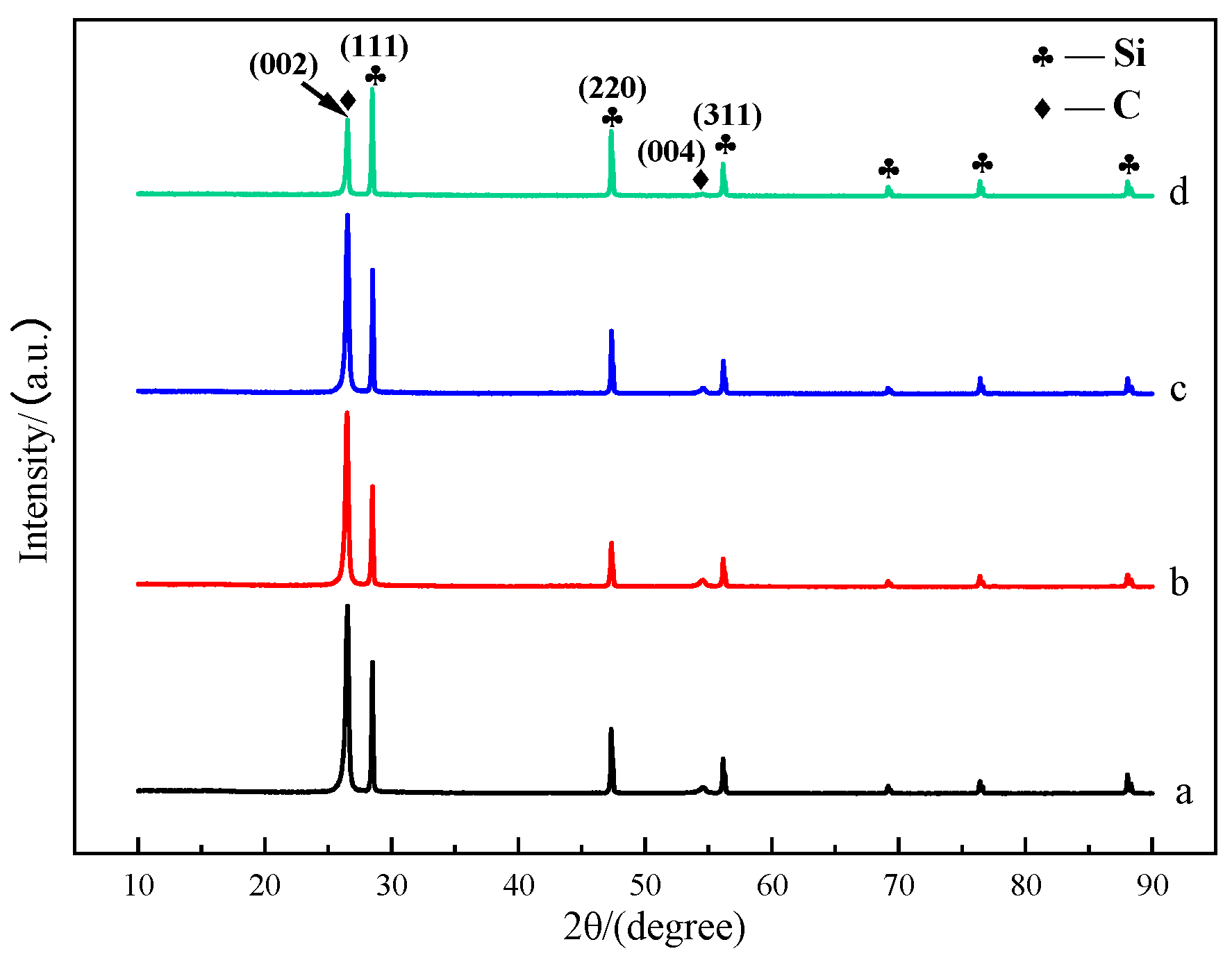
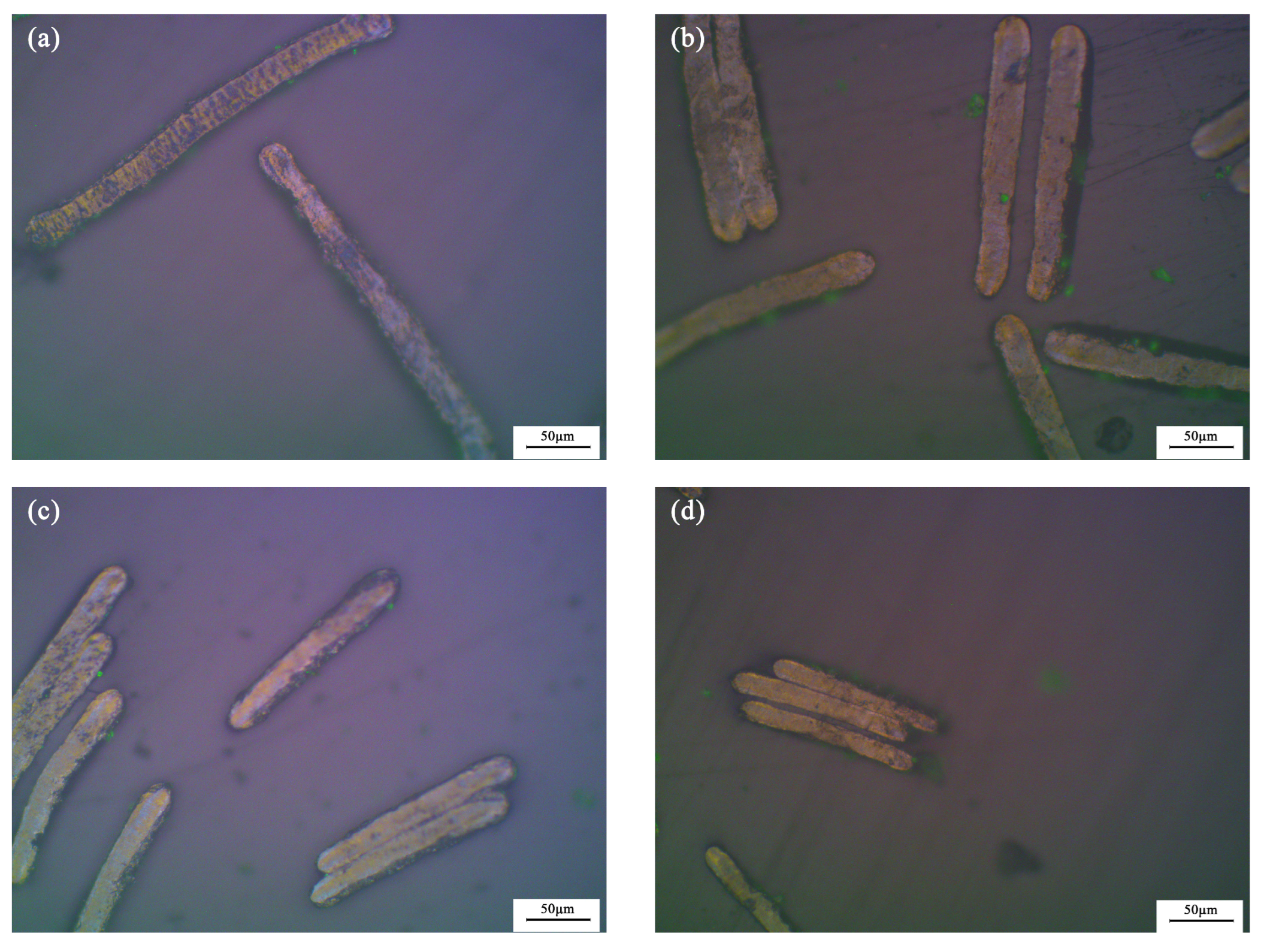


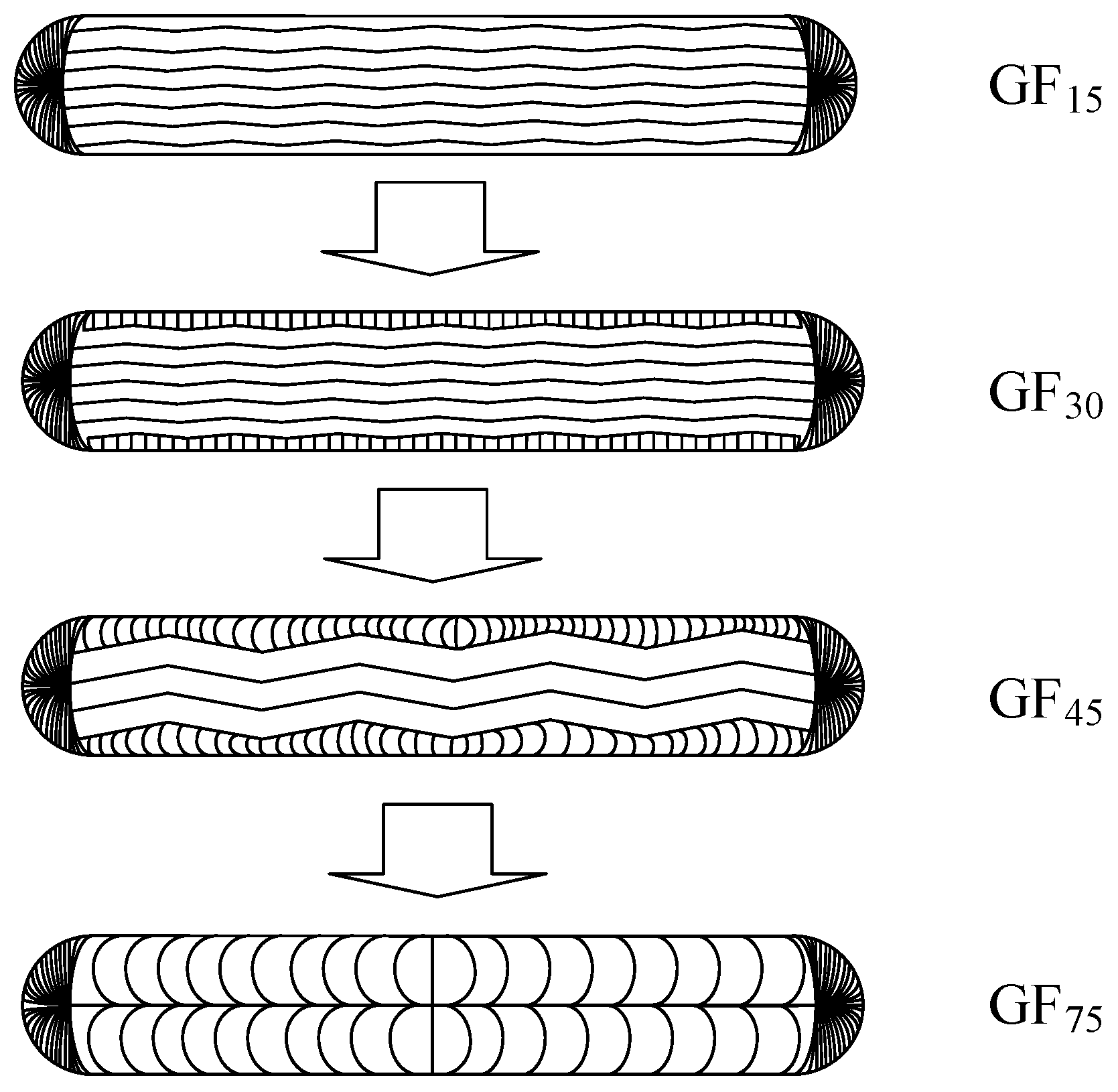
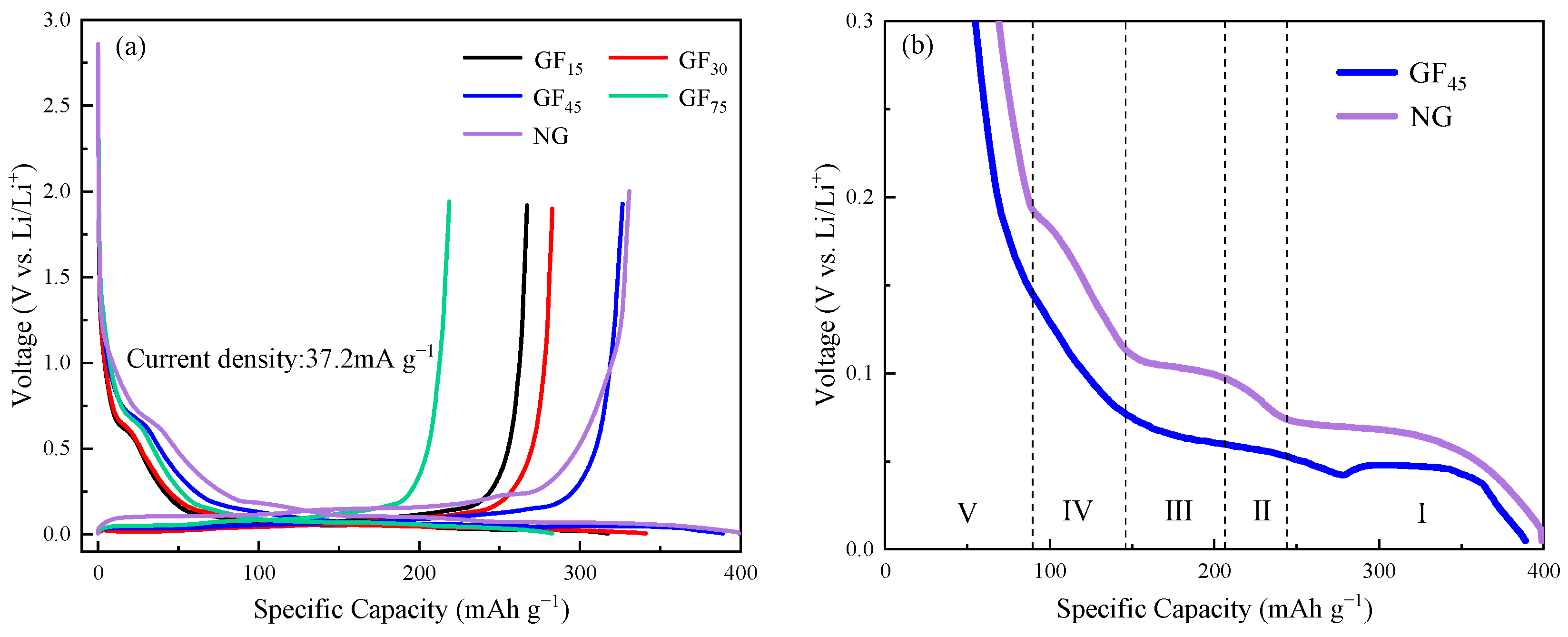


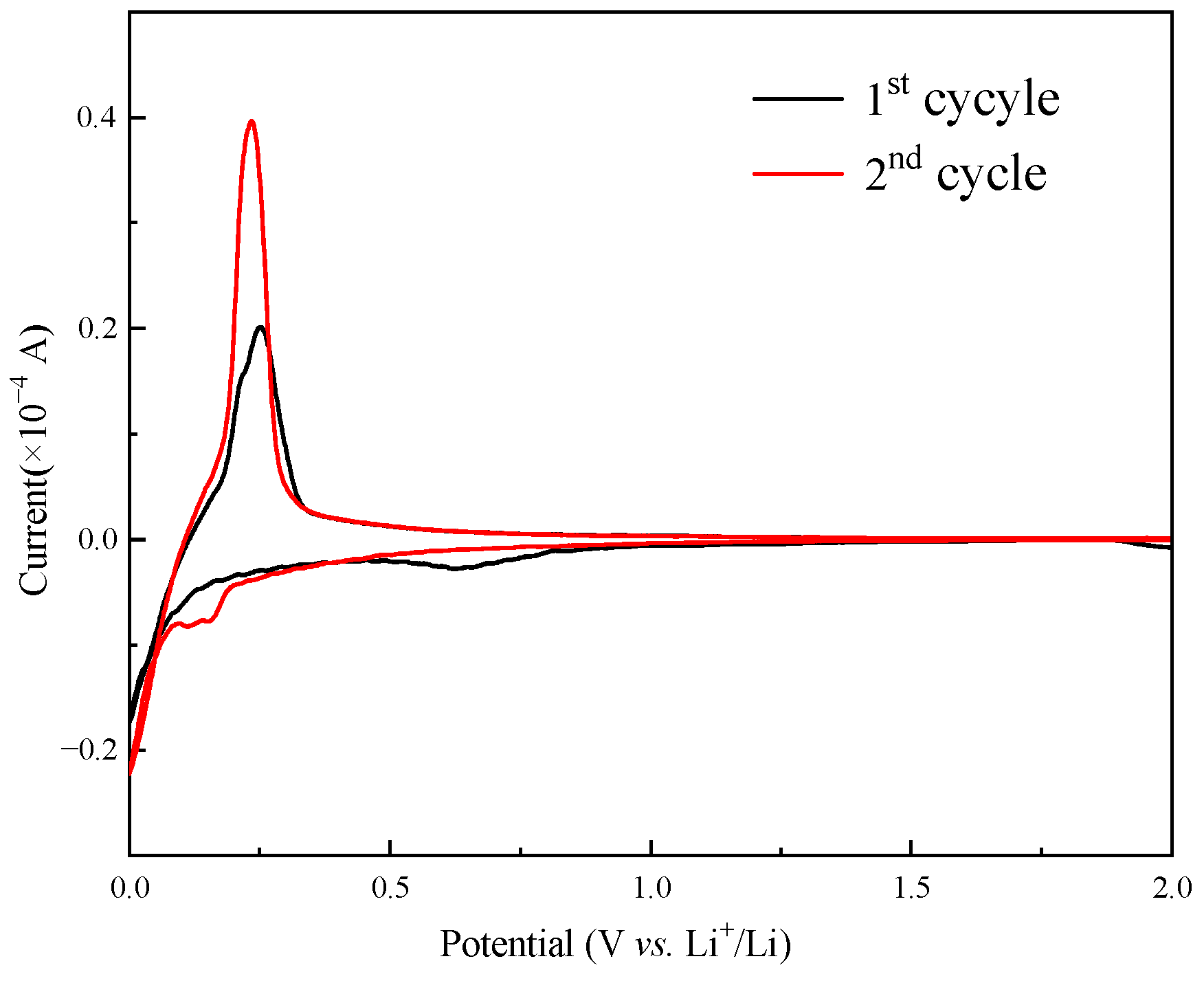

| Raw Materials | Softening Point (°C) | Content of Mesophase (%) | WTI (%) 1 | WQI (%) 2 | Mass Ratio of C Atoms/H Atoms |
|---|---|---|---|---|---|
| Mesophase pitch | 267 | 100 | 70.37 | 59.82 | 20.33 |
| Sample | d002 (nm) | g (%) | Lc (nm) |
|---|---|---|---|
| GF15 | 0.3367 | 85.40 | 31.09 |
| GF30 | 0.3368 | 83.43 | 29.02 |
| GF45 | 0.3368 | 83.89 | 29.72 |
| GF75 | 0.3369 | 82.77 | 28.97 |
| Sample | 1st Cycle | 10th Cycle | 100th Cycle | |||
|---|---|---|---|---|---|---|
| Charge Capacity (mA h g−1) | Discharge Capacity (mA h g−1) | Coulombic Efficiency (%) | Discharge Capacity (mA h g−1) | Discharge Capacity (mA h g−1) | Capacity Retention (%) | |
| GF15 | 317.6 | 267.0 | 84.0 | 288.6 | 275.2 | 95.36 |
| GF30 | 341.0 | 282.8 | 82.9 | 308.6 | 292.7 | 94.85 |
| GF45 | 388.9 | 326.5 | 84.0 | 334.7 | 327.8 | 97.94 |
| GF75 | 282.8 | 218.7 | 77.3 | 258.5 | 252.9 | 97.83 |
| NG | 398.8 | 330.7 | 82.9 | 338.2 | 289.7 | 85.66 |
Disclaimer/Publisher’s Note: The statements, opinions and data contained in all publications are solely those of the individual author(s) and contributor(s) and not of MDPI and/or the editor(s). MDPI and/or the editor(s) disclaim responsibility for any injury to people or property resulting from any ideas, methods, instructions or products referred to in the content. |
© 2023 by the authors. Licensee MDPI, Basel, Switzerland. This article is an open access article distributed under the terms and conditions of the Creative Commons Attribution (CC BY) license (https://creativecommons.org/licenses/by/4.0/).
Share and Cite
Li, J.; Wang, Q.; Zhang, J. Melt-Spinning Mesophase Pitch-Based Graphite Fibers as Anode Materials for High-Rate Lithium-Ion Batteries. Batteries 2023, 9, 550. https://doi.org/10.3390/batteries9110550
Li J, Wang Q, Zhang J. Melt-Spinning Mesophase Pitch-Based Graphite Fibers as Anode Materials for High-Rate Lithium-Ion Batteries. Batteries. 2023; 9(11):550. https://doi.org/10.3390/batteries9110550
Chicago/Turabian StyleLi, Jianlin, Qian Wang, and Jianhui Zhang. 2023. "Melt-Spinning Mesophase Pitch-Based Graphite Fibers as Anode Materials for High-Rate Lithium-Ion Batteries" Batteries 9, no. 11: 550. https://doi.org/10.3390/batteries9110550





